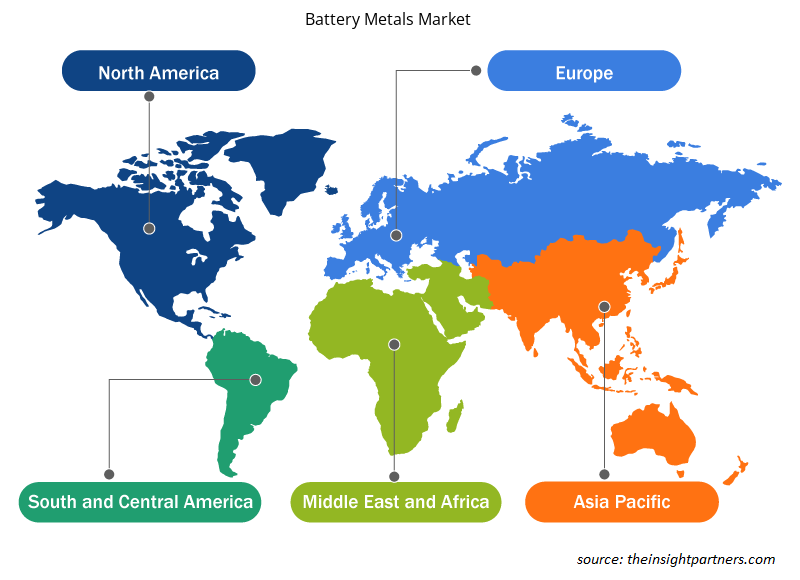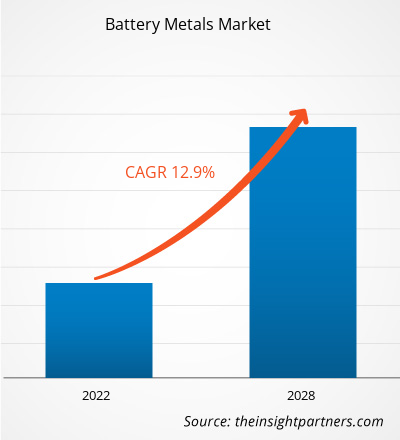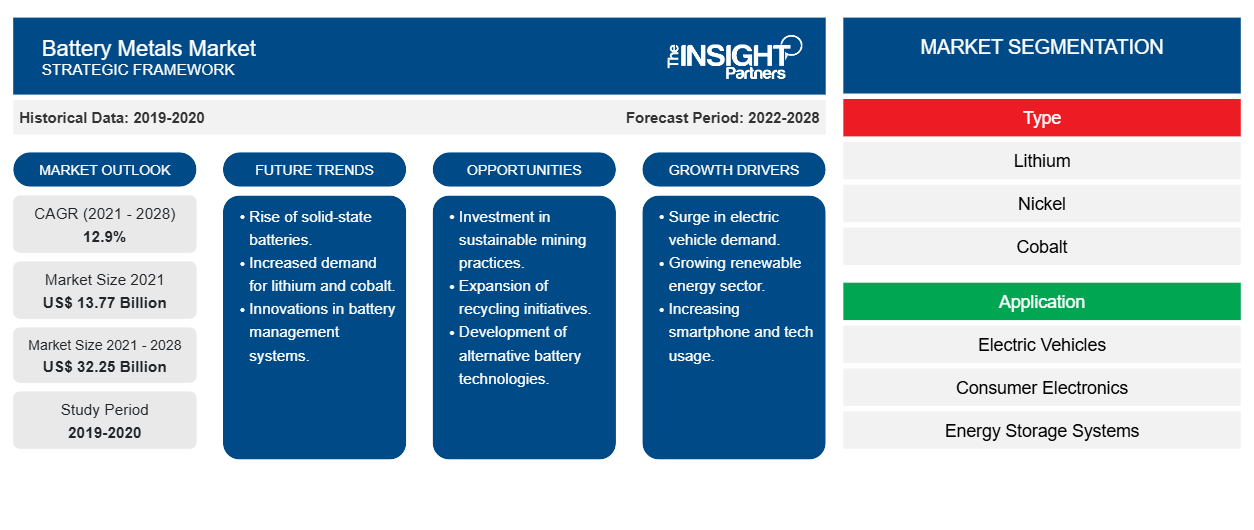[Rapporto di ricerca] Si prevede che il mercato dei metalli per batterie raggiungerà i 32.251,1 milioni di dollari entro il 2028, rispetto ai 13.770,9 milioni di dollari del 2021; si prevede che crescerà a un CAGR del 12,9% dal 2021 al 2028.
I metalli delle batterie come litio, cobalto, nichel e manganese sono usati come materie prime nella produzione di batterie. Sono usati anche nei veicoli elettrici, nell'elettronica di consumo e in altre applicazioni.
Nel 2020, l'Asia Pacifica ha detenuto la quota di fatturato più grande del mercato globale dei metalli per batterie . Vari paesi dell'Asia Pacifica stanno assistendo a un'impennata nei settori automobilistico ed elettronico, che probabilmente continuerà ad alimentare la crescita del mercato dei metalli per batterie durante il periodo di previsione. Inoltre, il mercato dei veicoli elettrici nell'area APAC ha assistito a una crescita notevole grazie alla rapida espansione del settore automobilistico ed elettronico.
Personalizza questo report in base alle tue esigenze
Riceverai la personalizzazione gratuita di qualsiasi report, comprese parti di questo report, o analisi a livello nazionale, pacchetto dati Excel, oltre a usufruire di grandi offerte e sconti per start-up e università
-
Scopri le principali tendenze di mercato in questo rapporto.Questo campione GRATUITO includerà analisi di dati che spaziano dalle tendenze di mercato alle stime e alle previsioni.
La pandemia di COVID-19 ha portato a interruzioni nella catena di fornitura globale. Molti settori, come quello minerario e quello chimico e dei materiali, hanno dovuto affrontare sfide senza precedenti nel rispettare i tempi di produzione e consegna e le vendite di vari beni. Tuttavia, poiché le economie pianificano di rilanciare le proprie attività, si prevede che la domanda di metalli per batterie aumenterà a livello globale. La ripresa delle attività nei settori automobilistico, elettronico e di altri settori ha aumentato la necessità di metalli per batterie a livello globale. Il settore dell'elettronica di consumo si sta espandendo dinamicamente con l'aumento delle spese dei consumatori. Si prevede che l'aumento della domanda di metalli per batterie in varie applicazioni, come veicoli elettrici, elettronica di consumo e sistemi di accumulo di energia, e gli investimenti significativi da parte di importanti produttori guideranno la crescita del mercato dei metalli per batterie nei prossimi anni.
Approfondimenti di mercato
Crescita del settore dei veicoli elettrici
L'aumento della domanda di veicoli elettrici a livello globale sostiene la crescita del mercato dei metalli per batterie. I prodotti a base di metalli per batterie sono ampiamente utilizzati dall'industria dei veicoli elettrici come sostituzione dell'energia fossile necessaria per il funzionamento dei veicoli. Nelle aree densamente popolate i veicoli elettrici sono ampiamente utilizzati per ridurre l'inquinamento dei veicoli poiché il numero di veicoli utilizzati è maggiore in tali aree. È anche un fattore importante per fornire diversificazione energetica e ridurre le emissioni di gas serra. I vantaggi dei veicoli elettrici includono zero emissioni allo scarico, il potenziale di riduzione delle emissioni di gas serra e una migliore efficienza rispetto ai veicoli con motore a combustione interna.
I governi di molti paesi, tra cui Cina, India e Stati Uniti, hanno approvato normative per incoraggiare l'adozione di veicoli elettrici. I veicoli elettrici e il loro mercato si stanno espandendo in modo significativo grazie al continuo progresso tecnologico nell'elettrificazione di veicoli a due/tre ruote, autobus e camion.
Secondo un rapporto dell'Agenzia Internazionale per l'Energia, 'The Global EV Outlook 2020', nel 2019 si è verificata una continua espansione delle scorte globali di veicoli elettrici per passeggeri, raggiungendo 7,2 milioni di unità, il 40% in più rispetto al 2018. A causa di tutti questi fattori, la domanda di veicoli elettrici/ibridi e veicoli elettrici/ibridi plug-in è in crescita. Ciò, a sua volta, sta guidando in modo sostanziale il mercato dei metalli per batterie.
Informazioni basate sul tipo
Per tipo, il mercato dei metalli per batterie è suddiviso in litio, nichel, cobalto e altri. Il segmento del litio ha detenuto la quota di mercato maggiore nel 2020. La crescita del segmento può essere attribuita alla crescente applicazione del litio nei veicoli elettrici e nell'industria elettronica grazie alla sua proprietà di leggerezza.
Approfondimenti basati sulle applicazioni
In base all'applicazione, il mercato dei metalli per batterie è ulteriormente segmentato in veicoli elettrici, elettronica di consumo, sistemi di accumulo di energia e altri. Il mercato dei metalli per batterie è dominato dal segmento dei veicoli elettrici che ha registrato il CAGR più elevato durante il periodo di previsione. La crescente domanda di veicoli privi di inquinamento dovuta al cambiamento delle norme normative da parte di varie autorità governative nei paesi sviluppati e in via di sviluppo sta creando un impatto enorme sul mercato dei metalli per batterie.
Albemarle Corporation; Umicore; LG Chem; Ganfeng Lithium Co., Ltd.; BASF SE; Bolt Metals Corp.; Honjo Metal Co., Ltd.; Lithium Australia NL; Vale; e Metso Outotec sono tra i principali attori che operano nel mercato dei metalli per batterie. Questi attori di mercato sono concentrati sullo sviluppo di prodotti innovativi e di alta qualità per soddisfare le esigenze dei clienti. Albemarle Corporation ha annunciato il lancio del Battery Materials Innovation Center (BMIC) presso la sua sede di Kings Mountain, North Carolina. Il laboratorio ha prodotto tecnologie di anodi di litio metallico che hanno aumentato la densità energetica della batteria utilizzando la laminazione avanzata di litio metallico per ottenere lamine di litio sottili 20 μm (vale a dire circa un quinto dello spessore medio di un capello umano) o più sottili. Jiangsu Ganfeng Power Technology Co., Ltd., una sussidiaria di Ganfeng Lithium Industry, si è ufficialmente trasferita in un nuovo stabilimento e ha migliorato la capacità produttiva tramite la sostituzione delle apparecchiature. Jiangsu Ganfeng offre sistemi di batterie al litio per veicoli industriali come prodotto principale per offrire ai clienti soluzioni di sistemi di alimentazione personalizzabili, a lunga durata e ad alta resistenza, esenti da manutenzione e agevolare l'iterazione dei veicoli industriali dalle batterie al piombo alle batterie al ferro-litio.
Segnala i riflettori
- Tendenze industriali progressive nel mercato globale dei metalli per batterie per aiutare gli operatori a sviluppare strategie efficaci a lungo termine
- Strategie di crescita aziendale adottate dai mercati sviluppati e in via di sviluppo
- Analisi quantitativa del mercato globale dei metalli per batterie dal 2019 al 2028
- Stima della domanda di metalli per batterie in vari settori industriali
- Sviluppi recenti per comprendere lo scenario competitivo del mercato e la domanda di veicoli elettrici
- Tendenze e prospettive del mercato, insieme ai fattori che guidano e frenano la crescita del mercato dei metalli per batterie
- Processo decisionale attraverso la comprensione delle strategie che sostengono l'interesse commerciale in relazione alla crescita del mercato globale dei metalli per batterie
- Dimensioni del mercato dei metalli per batterie in vari nodi del mercato
- Panoramica dettagliata e segmentazione del mercato globale dei metalli per batterie e delle sue dinamiche nel settore
- Dimensioni del mercato dei metalli per batterie in varie regioni con promettenti opportunità di crescita
Approfondimenti regionali sul mercato dei metalli per batterie
Le tendenze regionali e i fattori che influenzano il mercato dei metalli per batterie durante il periodo di previsione sono stati ampiamente spiegati dagli analisti di Insight Partners. Questa sezione discute anche i segmenti e la geografia del mercato dei metalli per batterie in Nord America, Europa, Asia Pacifico, Medio Oriente e Africa e Sud e Centro America.

- Ottieni i dati specifici regionali per il mercato dei metalli per batterie
Ambito del rapporto sul mercato dei metalli per batterie
| Attributo del report | Dettagli |
|---|---|
| Dimensioni del mercato nel 2021 | 13,77 miliardi di dollari USA |
| Dimensioni del mercato entro il 2028 | 32,25 miliardi di dollari USA |
| CAGR globale (2021 - 2028) | 12,9% |
| Dati storici | 2019-2020 |
| Periodo di previsione | 2022-2028 |
| Segmenti coperti |
Per tipo
|
| Regioni e Paesi coperti |
America del Nord
|
| Leader di mercato e profili aziendali chiave |
|
Densità degli attori del mercato: comprendere il suo impatto sulle dinamiche aziendali
Il mercato dei metalli per batterie sta crescendo rapidamente, spinto dalla crescente domanda degli utenti finali dovuta a fattori quali l'evoluzione delle preferenze dei consumatori, i progressi tecnologici e una maggiore consapevolezza dei vantaggi del prodotto. Con l'aumento della domanda, le aziende stanno ampliando le loro offerte, innovando per soddisfare le esigenze dei consumatori e capitalizzando sulle tendenze emergenti, il che alimenta ulteriormente la crescita del mercato.
La densità degli operatori di mercato si riferisce alla distribuzione di aziende o società che operano in un particolare mercato o settore. Indica quanti concorrenti (operatori di mercato) sono presenti in un dato spazio di mercato in relazione alle sue dimensioni o al valore di mercato totale.
Le principali aziende che operano nel mercato dei metalli per batterie sono:
- Società Albemarle
- Bulloni in metallo
- Azienda Ganfeng Lithium Co., Ltd.
- Umicore
- LG Chimica
Disclaimer : le aziende elencate sopra non sono classificate secondo un ordine particolare.

- Ottieni una panoramica dei principali attori del mercato dei metalli per batterie
Mercato dei metalli per batterie, per tipo
- Litio
- Nichel
- Cobalto
- Altri
Mercato dei metalli per batterie, per applicazione
- Veicoli elettrici
- Elettronica di consumo
- Sistemi di accumulo di energia
- Altri
Profili aziendali
- Società Albemarle
- Umicore
- LG Chimica
- Azienda: Ganfeng Lithium Co., Ltd.
- BASF SE
- Azienda
- Azienda
- Litio Australia NL
- Valle
- Metso-Outotec
- Elementi americani
- Analisi storica (2 anni), anno base, previsione (7 anni) con CAGR
- Analisi PEST e SWOT
- Valore/volume delle dimensioni del mercato - Globale, Regionale, Nazionale
- Industria e panorama competitivo
- Set di dati Excel
Report recenti
Rapporti correlati
Testimonianze
Motivo dell'acquisto
- Processo decisionale informato
- Comprensione delle dinamiche di mercato
- Analisi competitiva
- Analisi dei clienti
- Previsioni di mercato
- Mitigazione del rischio
- Pianificazione strategica
- Giustificazione degli investimenti
- Identificazione dei mercati emergenti
- Miglioramento delle strategie di marketing
- Aumento dell'efficienza operativa
- Allineamento alle tendenze normative























 Ottieni un campione gratuito per - Mercato dei metalli per batterie
Ottieni un campione gratuito per - Mercato dei metalli per batterie